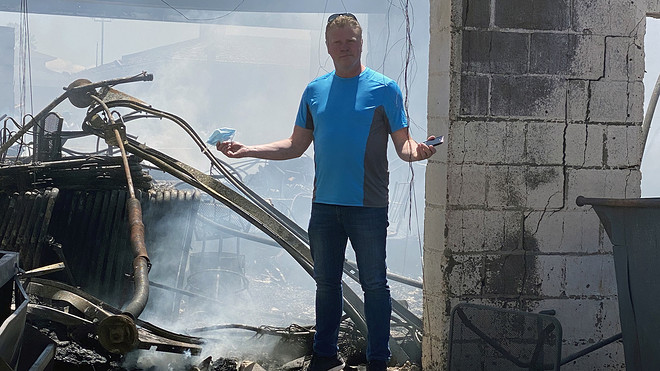Peter Killen was getting a bad feeling watching the local news on Friday night.
On his TV at home, he saw a familiar gas station. A fire was visible in the distance. It seemed to be near the warehouse where Killen, the owner of four bars in Minneapolis and the surrounding area, leased space for spare equipment.
Killen stored fryers there, wine coolers, patio bar stools, catering equipment and sentimental pictures too. The value of the items stored there was around $300,000 to $350,000. And by later that night, it was all gone.

Killen at the site of a burnt-down warehouse where approximately $350,000 in his equipment went up in smoke.
Courtesy Peter Killen
“There was nothing salvageable,” Killen, 49, told MarketWatch, later adding, “It’s just a pile of rubble and molten metal.” The patio furniture could have been useful for a patio-only reopening at his bars that was supposed to happen June 1 and is now a long way off.
“It’s never a good time, but it couldn’t have been any worse,” he said of the warehouse’s destruction.
From Friday to Wednesday, Killen says, he went from anger to acceptance. Now he’s getting ready for the next phase, the insurance claims process, and he’s far from alone.
The property destruction and looting during some of the protests over George Floyd’s May 25 death in police custody will cost insurers at least $25 million dollars — and that’s in Minnesota alone.
That estimate is according to Property Claim Services, an insurance industry company that monitors “catastrophes.” The word has special meaning for insurers, applying to large-scale man-made or natural disasters that will result in claims reaching at least $25 million.
On Saturday, the company designated the protests a “riot and civil disorder event” in the Minneapolis area. The label means the company expects insured losses to exceed $25 million.
By Tuesday, Property Claim Services updated its bulletin to say the protests had resulted in a “riot and civil disorder event” in multiple states.
It’s the first time the company determined for insurance purposes that a “riot and civil disorder event” was unfolding in multiple states, according to the company’s head, Tom Johansmeyer.
Property Claims Services, a division within Verisk Analytics, has catastrophe data going back to 1950, he noted.
Many of the demonstrations across the country have been largely peaceful, and Tuesday night demonstrations were some of the calmest yet. Still, there have been approximately 9,000 arrests nationwide and looting in Minneapolis and other major cities, including New York City, Los Angeles and Philadelphia.
Don’t miss:Apple is reportedly disabling and tracking looted iPhones
The $25 million price tag isn’t a projection on the actual insurance costs, Johansmeyer emphasized.
It’s essentially a heads up to carriers, telling them to get ready for an influx of claims and payouts. It will take around three weeks for the company to make an estimate on the insurance bill, he said.
Property Claims Services made its determinations about the “civil disorder event” by talking to insurance companies. “We take our cues from the insurers likely to be affected,” Johansmeyer said. “As of Friday, it was pretty thin. By Saturday, it was a different story.”
Homeowner and auto insurance policies can both cover damage from civil unrest, Johansmeyer noted. So can the business owner’s policies (BOPs) for small businesses and the layers of insurance that large companies use to protect themselves, he said.
A small business can expect to pay thousands a year in premiums for BOPs, according to Ron Wills, president and founder of the National Association of Business Owners & Entrepreneurs, a Washington D.C.-area business association. A mid-sized company can pay “tens of thousands” and premiums can jump to “hundreds of thousands” for large regional firms, he said.
Coverage for business interruption is critical at a time like this, said Wills, but not all policies include it.
It’s too soon to tell which types of policies will be paying for the damages, Johansmeyer said. “There could be some homeowner’s [insurance] in there, there could be some auto. Commercial is what we expect to be a little more significant.”
“It’s going to take a bit of time for the insurance industry to understand the full implication of this,” he said.
The largest riot-related insurance losses came after the 1992 Los Angeles riots, according to the Insurance Information Institute, an industry-funded consumer education association. Riots flared after four police officers were acquitted in the beating of Rodney King, a black man.
Insurers paid policyholders $775 million at that time for damages, according to the Insurance Information Institute. Adjusting for inflation, that’s $1.4 billion now, according to the Bureau of Labor Statistics’ inflation calculator.
Hurricane Katrina in 2005 was the nation’s most expensive insurance bill for a catastrophe. In the home, auto and commercial lines alone, insurers paid $41 billion to policyholders. That’s $55.1 billion adjusting for inflation now.
Back in Minnesota, the $25 million figure seems low to Killen.
His insurance agent told Killen to take precautions like boarding up the damaged space. “There’s nothing to board up. I couldn’t board it up if I even wanted to,” he said.
It might be some time before the insurance company could make it to the scene, the agent told Killen.
Killen’s four bars, including Kieran’s Irish Pub, have all gone unscathed so far.
He’s been closed since March 17 due to the state’s efforts to slow the coronavirus’ spread. That day happened to be St. Patrick’s Day — which could have been a good day for business, he noted.
Killen is trying to take the good with the bad. He’s supportive of the protests and hopes they will be a “milestone for change.”
“Hey the glass is half full,” said Killen. “We’re healthy. There’s only one way to go. That’s up.”










Add Comment